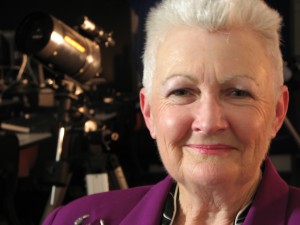 Cheryl Capra
Cheryl Capra
Cheryl Capra couldn’t pursue her passion for physics and astronomy as a career. Instead she turned to science teaching and, over a 40 year career, has taught at primary and secondary level and been involved in curriculum development.
But it’s in primary teaching at Albany Hills State School in Brisbane that she’s made her greatest impact. “Our students’ science studies extend from their classrooms and beyond this campus to our entire planet, even to the orbiting International Space Station and the cold, dark, unimaginable distances of the cosmos,” she says.
Since joining Albany Hills in 1999 Cheryl has led a strategically planned invigoration of science teaching and learning which is paying huge dividends in student achievement.
And the ideas that work at Albany Hills are being transferred to the wider Queensland school network through Cheryl’s broad range of professional development activities.
For her leadership in teaching and critical thinking, Cheryl Capra is awarded the 2007 Prime Minister’s Prize for Excellence in Science Teaching in Primary Schools.
Cheryl Capra was studying astrophysics in Germany when her family circumstances changed. She needed a job quickly and turned to teaching. Over 40 years later she has no regrets.
Her career has taken her from primary teaching to secondary, to curriculum and teacher development. And when considering retirement by 2000 after five years at the Education Department’s Central Office, she chose instead to return to primary school and science, where her passion and her rational outlook on the world are creating a generation of science-savvy young thinkers.
Cheryl jumped into the role of Science Coordinator in 1999 at Albany Hills State School in Pine Rivers Shire, just beyond Brisbane’s northern suburbs. She quickly identified two core issues: her student science scan indicated students weren’t taking a critical look at the world around them, and her survey of teachers indicated that 68% felt uncomfortable teaching science. She saw that as a concern for the intellectual growth of our future citizens.
“Young children exhibit intense curiosity about their world and how it works. We need to nurture that curiosity and harness it to stimulate imagination, develop observation skills and critical thinking, and to encourage understanding of what it means to hypothesise and fairly test ideas,” she says.
To address her concerns, Cheryl developed a two pronged initiative: A Community of Science Learning strategic plan; and a critical thinking curriculum programme called Touching the Future, based on the ideas of the US astronomer Carl Sagan and his Baloney Detection Kit. It aims to optimise opportunities for students to partake in real science while they learn to use the critical, evidence-seeking thought processes of science. Other elements of the initiative include a Scientist in Residence programme, community science expos and young scientist competitions.
Eight years later the results are apparent.
“Students are applying their ability to reason not just to issues in science, but across all curriculum areas from health to studies of society and science,” says Cheryl. “They are increasingly capable of critical questioning.”
Cheryl’s teaching programme has led to such dramatic improvements in primary students’ understanding of science that the local secondary school has introduced advanced classes to cater for students coming from Albany Hills.
Furthermore, Cheryl has not given up her deep love for astronomy. In fact, she has brought it into the classroom. “Astronomy is a gateway to the physical sciences,” she says.
Once again, the results of Cheryl’s initiative are strongly evident. Albany Hills now boasts an active astronomy club and is a recognised NASA Partner School. Cheryl’s students explore the sky manipulating NASA’s Las Campanas telescope and its digital cameras in Chile through a web interface.
Cheryl herself is an enthusiastic amateur astronomer. She serves as education officer and vice-president of the Astronomical Association of Queensland, and is contributing to a new project studying double stars and triple stars. The project team hopes to develop standard observation protocols to assist astronomers studying multiple stars.
Cheryl believes her greatest achievement is her contribution to the development of tomorrow’s critical thinkers.
Biographical details
2006 – Primary Connections’ trial teacher and Brisbane North District Coordinator implementing Primary Connections in the District’s schools
2006 – Science Teachers’ Association of Queensland Competition Committee member
2006 – District Science Committee member and Astronomy Club convener
2007 – Science Teachers’ Network member
2006- Astronomical Association of Queensland vice president & education officer
2004 – Scientist in Residence program organiser
2004 Awarded a Eureka Prize for research on ‘Touching the Future: teaching children to think critically through doing science’
2004 Initiated student & staff use of Sky Professional software for remote access to Las Campanas Observatory, Chile (Telescopes in Education, TIE International & NASA)
2004 Introduced astrophotography at the school
1999 – Teaching Year 7 full-time at Albany Hills State School, School Science coordinator
1998 Taught year 6 / 7 composite full-time at Albany Hills State School
1991-96 Curriculum development at Queensland Department of Education
1991 Regional Coordinator, Languages (acting) based Kedron State High School
1985 – 1987 Goethe Institut scholarship, German linguistics, Prien am Chiemsee, Germany
1984 Ferny Grove Primary / Secondary Cluster,
1967 Lawnton State School
1966 Began teaching: Bald Hills Primary School, Queensland.
1965 Diploma of Teaching, Kedron Teachers’ College / College of Advanced Education (now Queensland University of Technology)


